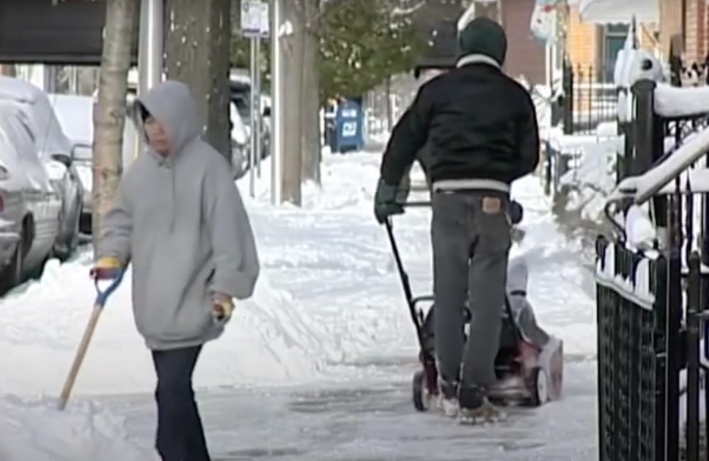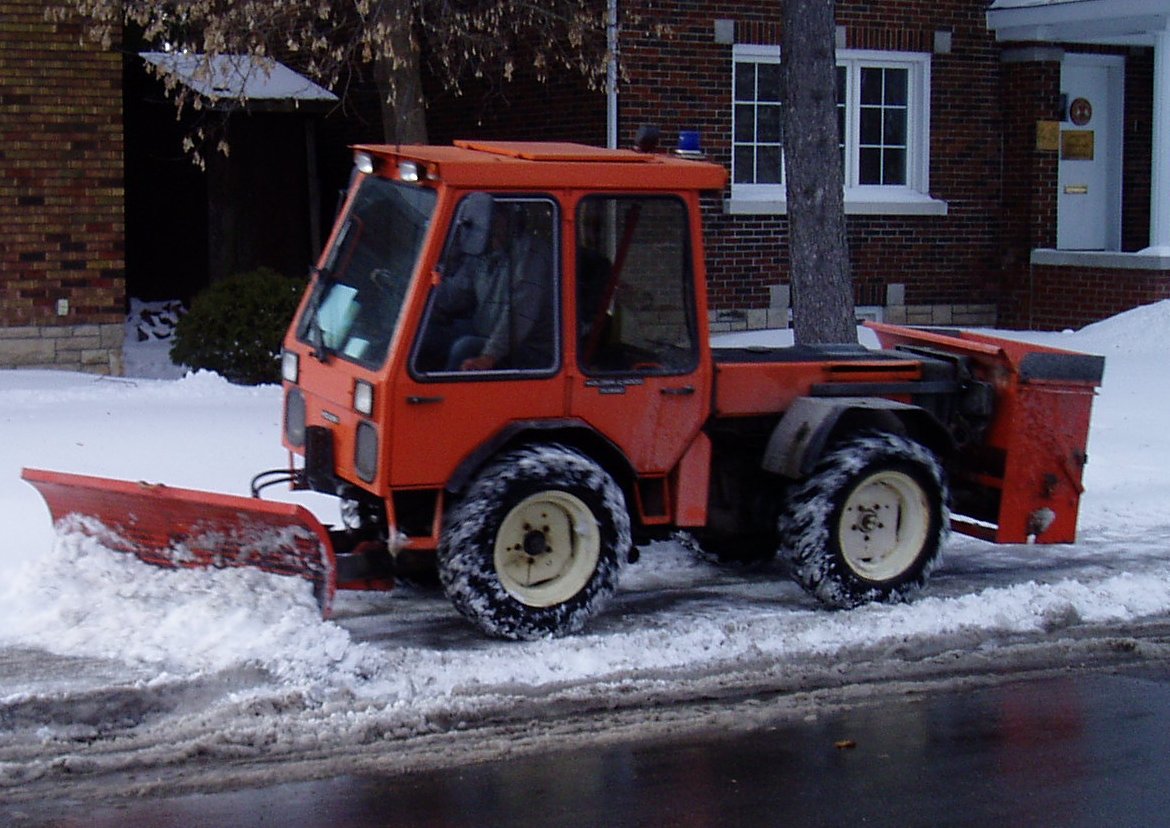Michael Podgers is an organizer for the local sustainable transportation advocacy group Better Streets Chicago.
Imagine if you were required to shovel out the travel lane in front of your property every time it snowed. Now, imagine how you would feel after laboring in the snow, along with your neighbors, if one-person failed to clear the street in front of their property, making it impossible for vehicles to pass, despite everyone’s effort. It would feel pretty pointless doing all this work only to have the overall job left undone. Of course, that isn’t how roads are cleared of snow in Chicago, but it is how sidewalk snow clearance is handled.
Travel lanes – the portion of street where people drive cars, trucks, and buses – only make up about half of the city’s public-way infrastructure. The other half consists of everything else: planted medians, parking lanes, bus stops, benches, bike racks, sidewalks, etc. The city of Chicago generally puts the responsibility for clearing all this other public-way infrastructure of snow to residents, property owners, or business owners. The result is dangerously haphazard sidewalk snow clearance. This doesn’t have to be the case though, because sidewalk snow clearance that's done by the municipality is not only possible, it is already a widely-practiced reality in other wintery cities.
Better Streets Chicago, first called on City Hall to adopt a sidewalk municipal snow clearance plan with a petition (sign here) and social media campaign following last February's unusually high snowfall – over 20 inches in a month. With such heavy snowfalls and other winter extremes like polar vortexes likely to become more common due to climate change, it is imperative that Chicago manage snow clearance better and more equitably. As it stands, the city unfairly prioritizes plowing the roads for drivers as a public good that must be funded with taxpayer dollars, whereas clearing the sidewalks for pedestrians is an unfunded, spottily-enforced mandate.
Better Streets' goal is simple: City Hall must take complete responsibility for managing snow clearance of all public way infrastructure. This includes sidewalks and bike lanes, bus stops, bike racks, and crosswalks in addition to travel lanes. This should be done to create parity in services for people who drive and those who don’t. We must make sure the city is always accessible to every resident, regardless of their age, ability, income, or preferred means of transportation. This policy should have been in place already, but we’ll settle for it being implemented by December 2022.

The advantages of shifting responsibility for public-way snow clearance from citizens to the city will be significant. The clearest benefit will be everyday Chicagoans never having to get up and trudge out into the snow to clear public sidewalks again.
Another advantage would be the city's ability to coordinate clearance to prevent essential infrastructure like bus stops and crosswalks from being plowed in when travel lanes are cleared. It would ensure consistent adherence to municipal snow clearance guidelines while giving the voters the ability to elect or reject office holders who succeed or fail in providing these services.
There's a precedent for this sort of thing: Mayor Michael Bilandic lost reelection after he failed to get the streets cleared in a timely manner during the Chicago blizzard of 1979. That's one reason the city has been so fastidious about plowing travel lanes ever since.
There are also many less obvious benefits from Better Streets' proposal to shift snow clearance duties to the city. It would end the current policy’s system of double taxation. Despite residents and businesses paying taxes to the city to deliver services, in this instance City Hall has turned around and put the burden of providing the time and labor to deliver a public good onto the tax paying public itself. This is especially galling considering the city simultaneously will fine up to $500 to property owners who fail to deliver what should (and must) be a municipal service.
The current policy, specifically outlined by the Municipal Code of Chicago (4-4-310 & 10-8-180), is not just a public service failure or a form of double taxation, it is also incredibly inequitable. Fines and fees systems to receive or force delivery of public services burden lower income households far more than wealthier households.
A $500 fine represents 12 percent of the monthly income for a family of three making $50,340, or 60 percent of the Chicagoland Area Mean Income. Such households are also less likely to have the capacity to clear snow in a timely manner. There is a time-cost to snow clearance. And, unlike wealthier residents, they may not earn enough to buy a snow blower or to pay for somebody to perform the task.
More egregious is how the current policy treats people with mobility challenges. This is something the city even acknowledges, stating on the “Sidewalk Snow Removal” page of its website that “many people rely on walking and transit as their primary way to get around, and without a wide, clear path through snow and ice, it is especially difficult for people with disabilities, seniors, and children to walk safely.” Well, duh.
City of Chicago video encouraging private citizens to clear their own sidewalks.
It begs the question whether the city has ever spoken to or listened to these populations. After launching the #WalkableWinters petition last year, Better Streets Chicago organizers learned extensively what sidewalks made impassable by snow means for residents with limited mobility. Spoiler: It makes life miserable.
We learned from people using wheelchairs and walkers, that heavy snow can mean being trapped at home for days. This can disrupt people’s ability to perform basic tasks like errands. It can make it difficult to get to work or appointments. It limits people’s ability to exercise, get fresh air, or socialize – all of which are vital for mental well-being. People in wheelchairs can get trapped in snow drifts or otherwise be forced to use active roadways. Guide dogs can get disoriented when well-trod paths disappear under inches of snow or become too narrow for them to navigate while walking besides (not behind or in front of) their person. If anything, this makes clear that the city’s current sidewalk snow clearance policy is non-compliant with Title II of the Americans with Disabilities Act, which "prohibits discrimination against qualified individuals with disabilities in all programs, activities, and services of public entities."
The experiences of peer cities across the country and the world demonstrate that a viable alternative exists. Rochester, New York, clears snow from public sidewalks after four inches of snow accumulates. Denver is investing in the necessary plows to implement a similar program. The western Chicago suburb of Forest Park already uses Bobcats with plows to do the job.
Interestingly, many communities in Sweden and Finland have even begun clearing snow from sidewalks and bikeways first (and roads last), which has shown to improve safety by decreasing falls and expanding winter travel opportunities without noticeably impacting drivers. Another reason this policy is in place in Sweden is gender parity: Data showed that plowing streets first disadvantaged women, who were more likely to walk than men.
The best examples of municipal snow clearance Better Streets Chicago has identified come from Canada. Both Toronto and Montreal clear all municipal public-way infrastructure. In both cities, residents are only responsible for clearing private property. Canada’s largest cities provide a great example for Chicago to mimic due to the three cities' many similarities. All developed largely during the same period with similar development patterns. Toronto and Chicago are almost identical in terms of population, land area, and street-network size. All three have near-equivalent population densities with comparable urban scales. What differentiates the two from Chicago is one thing: Toronto and Montreal each get significantly more snow than Chicago on average (48 inches and 83 inches respectively, versus 32 inches).
We know from these example that a municipal snow clearance plan can be implemented and made successful in Chicago. We know that such a plan would greatly benefit the entire public and especially benefit disadvantaged populations. And we know the city has the resources to implement such a program. Toronto spends less than $73 million U.S. dollars on all public way snow clearance. Compare that to the $1.69 billion Chicago is spending this year on policing.
However, Better Streets believes that municipal sidewalk snow clearance is a service worth funding regardless of the cost. We must demand our tax dollars be spent on services with a clear material benefit to the average citizen and which elevates historically marginalized communities. We know from the distribution of public dollars in Chicago’s budget, that the money exists to implement such a program. The mayor and the City Council and have resisted shifting tax dollars to the types of services and programs that truly benefit the general public. It’s time we set new expectations for public spending and demand those get met. This includes making changes to how we manage our streets, whether in rain or shine, snow or ice.
So, please join us in our call to make Chicago’s winters walkable.




